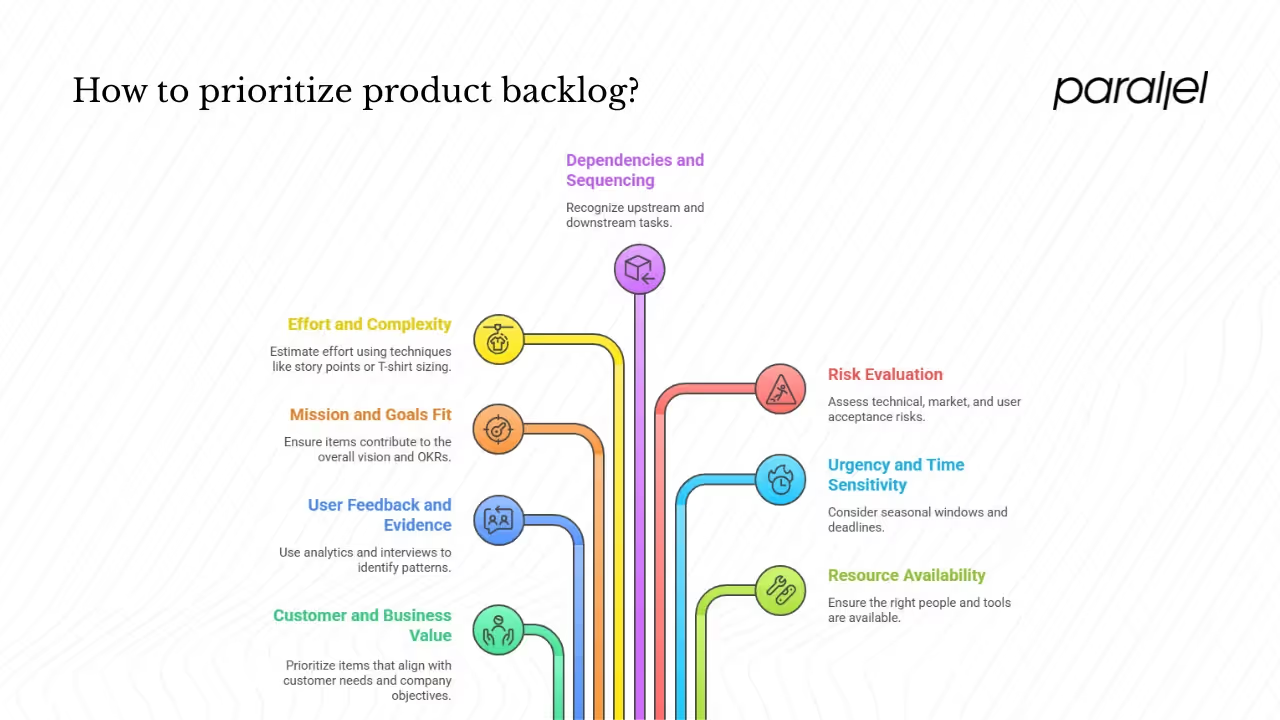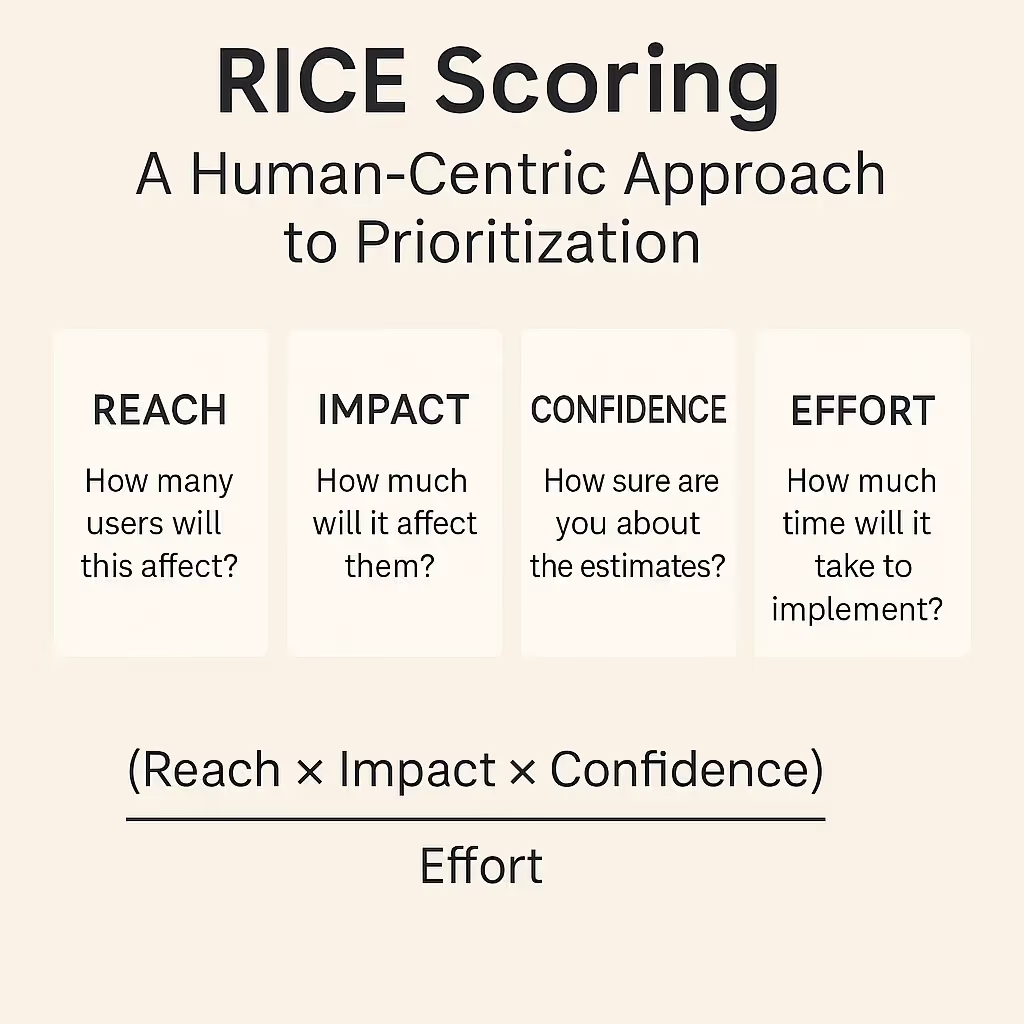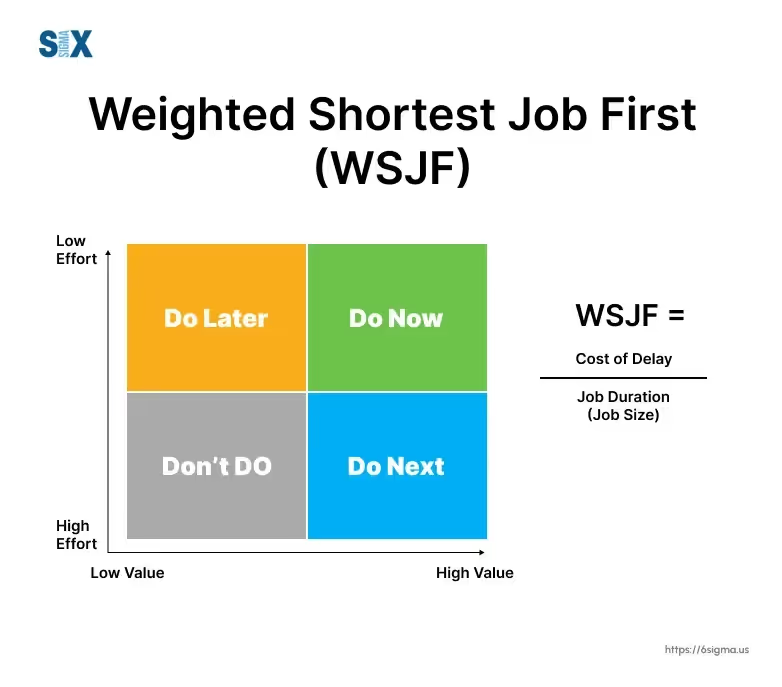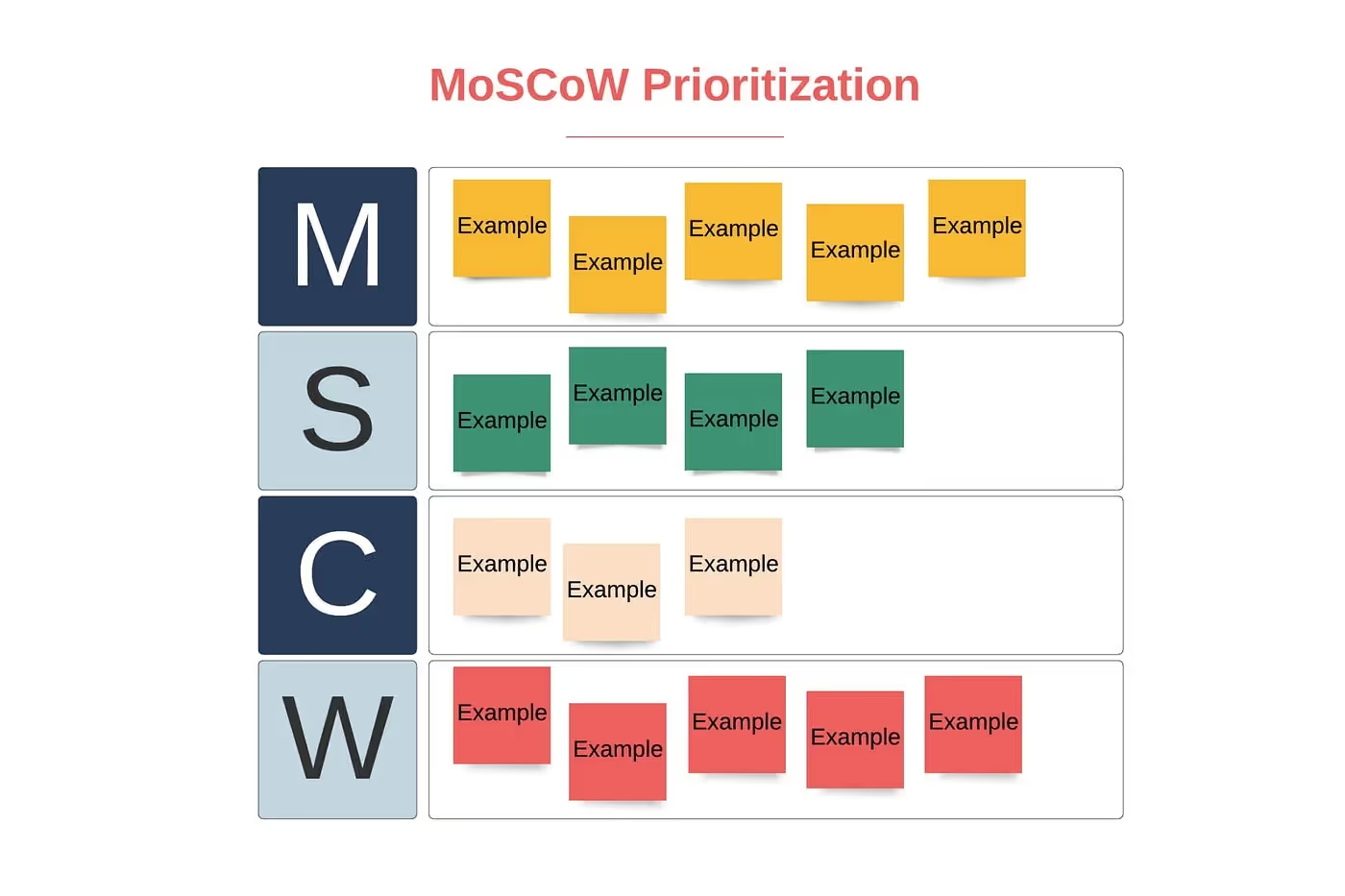How to Prioritize Product Backlog: Complete Guide (2025)
Understand how to prioritize your product backlog using frameworks and techniques to ensure the most valuable features are developed first.

At early‑stage companies, you often juggle competing demands—from urgent customer requests to technical cleanup—with limited resources. Every decision feels fraught. How do you decide what comes next? In this guide I’ll show you how to prioritize product backlog. We’ll cover core concepts, the factors that matter and a practical process to help you focus your runway on what matters most.
What is a product backlog?
In Agile and Scrum, the backlog is a single ordered list of work for your product team. Productboard defines it as a list of tasks and requirements that serves as a single source of truth. It contains user stories, bug fixes, technical tasks and research spikes. Items at the top are candidates for the next sprint; the rest stay further down until they’re ready to be pulled. The product owner or product manager is responsible for keeping the backlog ordered, but developers, designers and stakeholders contribute ideas and feedback. The backlog is not a dumping ground for every idea; it’s a curated queue that reflects your strategy and user needs.

Ordering versus prioritisation
Many people talk about “prioritising the backlog,” but in Scrum we care about ordering. The Scrum Guide emphasises that the backlog must be fully ordered rather than labelled with high/medium/low. Ordering looks at the entire queue and asks, Which sequence of work maximises value? Pair‑wise ranking without considering dependencies or timing can lead to sub‑optimal results. For instance, a large feature that drives revenue might logically come after a small technical enabler, even if its individual priority score is higher.
Refinement keeps it useful
Backlog refinement (or grooming) is the ongoing practice of reviewing, editing and re‑ranking items. Atlassian describes refinement as reviewing and ranking the backlog to ensure it reflects current customer insight and business goals. During refinement sessions the team splits large items into smaller stories, adds acceptance criteria and estimates effort. Without refinement, the backlog grows stale and bloated, making sprint planning painful. Plan to revisit the backlog every sprint or at least every couple of weeks to keep it actionable.
Factors to consider
Deciding how to prioritize product backlog requires looking at more than just popularity. Based on years of working with early‑stage startups, I suggest balancing the factors below:
- Customer and business value – Value encompasses revenue potential, user satisfaction and strategic impact. According to Productboard, user stories, bug fixes and technical tasks should all tie back to customer needs and company objectives. The 2024 State of Product Management report confirms that customer needs and company goals are the top drivers.
- User feedback and evidence – Use both analytics and interviews. Look for patterns across multiple users.
- How well it fits your mission and goals – Ask whether a candidate item contributes to your vision or OKRs. Don’t build features that don’t fit your strategy.
- Effort and complexity – Use relative estimation techniques like story points or T‑shirt sizing. Lucid explains that T‑shirt sizing (XS to XL) helps teams quickly gauge relative size and identify large items to be broken down. Planning poker encourages consensus by having people reveal estimates simultaneously.
- Dependencies and sequencing – Some items depend on others. Recognise upstream and downstream tasks so you don’t schedule work that can’t start.
- Risk – Evaluate technical risk, market risk and user acceptance risk. A feature that uses a new technology might be riskier than a minor improvement to an existing flow. Assigning a risk score helps you decide whether to tackle it sooner (to reduce uncertainty) or later.
- Urgency and time sensitivity – Value can decay over time. ProductPlan observes that a feature that generates significant revenue may outrank a smaller, quicker win. Consider seasonal windows, customer contracts or regulatory deadlines when setting orders.
- Resource availability and stakeholder input – Do you have the right people and tools? An item may score high on value but may have to wait if a specialist is unavailable or if you need approval from another team. Involve teammates and stakeholders so decisions reflect a range of perspectives.

By considering these factors together, you can make decisions that balance short‑term wins with long‑term strategy. Some teams use scorecards to assign numeric values to each factor and compute an overall score.
Frameworks for ordering
There is no one right way to order your backlog. Different methods suit different contexts. Here are four common approaches and when to use them.
Custom scoring

Custom scoring is flexible. You list criteria (value, complexity, risk, urgency, etc.), assign relative importance to each and score items on a consistent scale. Multiply each score by its percentage and sum the results. This approach forces you to spell out what matters and provides a transparent rationale for decisions. At Parallel we’ve used this technique to help early‑stage teams reason about trade‑offs before they have strong data.
RICE method

RICE stands for Reach, Impact, Confidence and Effort. Atlassian explains that you multiply reach (how many users are affected), impact (degree of improvement) and confidence (certainty about your estimates), then divide by effort. A high RICE score suggests a feature that affects many users, has a strong impact and can be delivered quickly. The method can be time‑intensive because you need data and agreement on definitions.
WSJF (relative priority ratio)

WSJF comes from the Scaled Agile Framework. It computes the ratio of cost of delay to job size. Cost of delay includes user or business value, time criticality and risk reduction. Job size refers to relative effort, often estimated using a Fibonacci sequence. Divide cost of delay by job size to see which items deliver the most value per unit of work. This method helps prioritise large initiatives but may be overkill for small teams.
MoSCoW categorisation

MoSCoW groups features into Must have, Should have, Could have and Won’t have. It’s straightforward and works well for communicating with non‑technical stakeholders. However, teams often classify too many items as “must have,” which weakens the distinction. Use MoSCoW for MVP planning or when you need a quick sanity check.
Teams often mix these methods—for example using custom scoring for day‑to‑day decisions and WSJF for epics—to create a clear and consistent process.
A practical process
Here’s a repeatable process you can follow. It synthesises the factors and frameworks above and draws on lessons from startups we’ve advised.
- Agree on criteria and relative importance. Meet with your team to decide which factors matter most now and how much influence each has. For example, you might decide value counts for 40% of the score, urgency 30%, effort 20% and risk 10%. Document these percentages to avoid confusion later.
- Refine items. Break large epics into smaller, testable stories. Add acceptance criteria and ensure each item is specific enough to estimate. Atlassian notes that refinement includes splitting and adding details.
- Estimate effort. Use story points or T‑shirt sizes to gauge complexity. Choose a method that encourages conversation and consensus. Avoid tying points directly to hours; instead talk about relative difficulty.
- Score and rank. Apply your chosen framework—whether custom scoring, RICE or WSJF—to compute a score for each item. Use a simple spreadsheet to compute scores and compare them.
- Adjust for dependencies. Look at technical and organisational dependencies. If item A must be done before item B, reorder accordingly even if the scores differ. Also consider resource constraints—if a specialist is unavailable, some work may need to wait.
- Finalise the next batch. Identify the top few items for the next sprint or release. Keep the backlog lean by parking long‑term ideas elsewhere. Fibery warns that bloated backlogs can be ineffective.
- Share and iterate. Present the ordered backlog to stakeholders and explain the rationale. Productboard advises inviting stakeholders into the process to increase transparency and buy‑in. After each sprint, revisit scores and reorder as new information comes in.
This process can be simple. The point is to have a shared mental model for how to prioritize product backlog so you don’t default to gut instinct or the loudest voice.
Pitfalls and tips
Ordering a backlog is tricky. Here are common mistakes and ways to avoid them:
- Loud voices dominate. Without structure, senior stakeholders or passionate customers can override objective criteria. Ground discussions in your chosen frameworks.
- Chasing quick wins. Teams sometimes pick only low‑effort tasks and neglect strategic work. Balance fast wins with big bets.
- Overfilled queues. A backlog with hundreds of items is impossible to manage. Keep a separate parking lot for long‑term ideas.
- Static order. Conditions change. Revisit the backlog regularly and adjust based on new data.
- Ignoring technical debt. Maintenance and refactoring seldom rank high on value but are vital for long‑term health. Incorporate risk reduction into your scoring.
Tips for success:
- Maintain a small list of items you intend to build soon.
- Invite engineers, designers and customer‑facing teams to refinement. The 2024 report observes that while 73% of product managers participate in user research, only 45% of designers and 23% of tech leads are involved. More voices lead to better decisions.
- Record a short justification for top items. This makes it easier to explain ordering to stakeholders later.
- Record a short justification for top items. This makes it easier to explain ordering to stakeholders later. These habits will support how to prioritize product backlog every sprint.
Conclusion
Ordering a product backlog is hard because it touches on strategy and user needs. A backlog is not just a list—it is a guide to what you will build next, and it must be fully ordered. To make the right calls, mix quantitative data with qualitative insight and involve your team. Use frameworks like custom scoring, RICE or WSJF to bring rigour, but don’t follow formulas blindly. Set clear criteria, refine items, estimate effort, compute scores and adjust for dependencies. Share the results and revisit them regularly. How to prioritize product backlog is not a one‑off project; it’s an ongoing practice that will keep your product focused on the things that truly matter. Refining how to prioritize product backlog will sharpen your judgement over time. By applying the ideas in this guide and practising them each week, you will see how clarity grows and your team becomes more confident in deciding what to build next.
Frequently asked questions
1) How do you prioritize a product backlog?
Start by defining the criteria that matter—value, urgency, complexity, risk and dependencies. Assign relative importance to each and agree on them with your team. Break items into clear stories and estimate effort. Use a framework like custom scoring or RICE to compute a score for each item, then order them by score. Adjust for dependencies and capacity constraints. Review the result with stakeholders, then refine it after each sprint. This is the essence of how to prioritize product backlog.
2) What should be the order in a product backlog?
The top items should be those with high business or user value, high urgency and manageable effort. Next comes high‑value but larger tasks. Lower‑value or speculative ideas belong further down or in a separate list. Technical debt and enabling work should be interwoven to avoid future bottlenecks. A single ordered list provides clarity to the development team.
3) How often should you revisit your backlog order?
At least once per sprint during refinement sessions. You should also revisit it whenever you receive major customer feedback, when the market or technology shifts or when team capacity changes. Regular review ensures the backlog stays relevant.
4) Can you mix prioritisation methods?
Yes. Many teams use custom scoring for everyday decisions and WSJF for big epics. Others use RICE for experiments but adjust ordering based on stakeholder input. The essential point is to be transparent about your method and apply it consistently. As long as you agree on how to prioritize product backlog, mixing methods can work well.




.avif)








